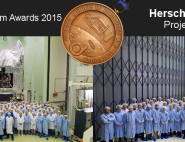The farther parts of the Solar System according to Herschel
On the borders of the Solar System, at billions of kilometers from the Sun, the exploration of primordial objects is progressing. Thanks to the ESA's space observatory Herschel, a team from the Laboratoire d'Etudes Spatiales et d'Instrumentation en Astrophysique of Paris Observatory - LESIA - got more accurate and unprecedented data on nine primitive objects, transneptunians and Centaures, of the outer Solar System.
The Transneptunian objects (OTN) and the Centaures are small frozen bodies in orbit around the Sun. They travel on the borders of the Solar System, beyond Neptune for some of them and between Jupiter and Neptune for the others. They are the more primitives bodies known of the Solar System.
![]()
The dwarf planet Quaoar
seen at 70 µm,
in the far infrared, by Herschel.
(ESA/PACS/Paris Observatory/LESIA)
The observation data of these nine objects, made by the two instruments PACS and SPIRE, reveal unprecedented data. The observed objects comprise: the dwarf planet Haumea, two among the biggest transneptunians (Orcus and Quaoar), and the two biggest Centaures known to this day (Chiron and Chariklo). The acquired data enable to measure, with an unparalleled accuracy and in a spectral domain never observed before, their size, their albedo and their thermo-physical properties.
Read the Press Release from the Paris Observatory (in French)
Publication:
"TNOs are Cool: A survey of the Transneptunian region. VIII. Combined HERSCHEL PACS and SPIRE observations of 9 bright targets at 70-500 micron", Sonia Fornasier, Emmanuel Lellouch, Thomas Mueller and coauthors to be published in Astronomy & Astrophysics.


